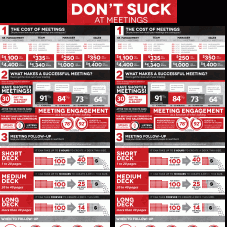 As business leaders we’re constantly shaping and re-shaping our strategies. We have to pay attention to the developments around the world in order for our companies to succeed because our strategies are intertwined with market forces that affect consumers and demand.
As business leaders we’re constantly shaping and re-shaping our strategies. We have to pay attention to the developments around the world in order for our companies to succeed because our strategies are intertwined with market forces that affect consumers and demand.
Mark Pollard wrote a theoretical blog post on how to shape strategies. He says, “The great thing about strategy-in-shapes is it makes your thinking look very deliberate, impossibly official, and crazy to mess with.”
The concepts he plays with the most are:
First, bring together useful information about your brand, business objectives, products, competition, culture, and human behavior. Take a look at analytics, do keyword research and look for patterns, look at consumer reviews, and use qualitative research if available to you.
Pollard comes up with a few strategies based on the information he’s gathered. He says, “I tend to dig then sprint and let it all percolate…then repeat.” When putting strategies together he finds it useful to close the door and think, open it to share and debate, then close it to hone in.
To shape a strong strategy, embrace strong, visual language. Pollard suggests taking your three favorite strategies and rewriting them 10 times each. Keep making them shorter and stronger, easy to understand. Bring your ideas to your team and collaborate with them. They may be able to offer you even better ideas to help execute your strategy.
Pollard suggests taking the one or two strategies your team favors and writing stories around them. He says in the story, take someone on the journey you’ve just been on from the problem, to the twist, to the ‘what if we…?’, to the answer. This can help you put your thoughts together in a more direct way.
Set a clear direction for your company whether it’s cutting costs, expanding services, or improving infrastructure. If you have broad priorities, make clear guidelines your employees understand and can act upon.
According to this article on the HBR Blog Network by Donald Sull and Kathleen Eisenhardt, successful companies shape their high-level strategies by relying on simple rules of thumb.
In shaping strategies, Sull and Eisenhardt offer four simple rules to follow:
Sull poses three questions to break down complex strategies into actionable steps:
Sull says to translate corporate objectives into a few straightforward guidelines that help employees make on-the-spot decisions and adapt to constantly shifting environments, while keeping the big picture in mind. He also says, “For a strategy to influence action it must be remembered. To be remembered it must be understood. To be understood it must be simple.”
What techniques do you use to shape your strategy?
 Did you know, constantly listening to a coworker complaining can actually undermine your work?
Did you know, constantly listening to a coworker complaining can actually undermine your work?
Listening to too much complaining is bad for your brain in multiple ways, according to Trevor Blake, author of Three Simple Steps: A Map To Success in Business and Life.
In Inc. magazine, Geoffrey James discussed how to turn workplace whiners into productive team members, and Sue Shellenbarger of the Wall Street Journal also offered tips on what to do with a workplace whiner.
Unfortunately, there are many people who would rather complain than take action.
Following are six ways to handle workplace whiners:
Don’t let a known office complainer interrupt what you’re doing. Let them know you want to hear what they have to say, but you can’t give the matter attention while your mind is on your current task. This will limit the affect the complainer has on your productivity and also conveys a willingness to listen.
If scheduling a conversation doesn’t work, try changing the subject. Ask the complainer what is going well. Try and get them to focus on the positive instead of the negative.
Ask the complainer if they need solutions or they just need to vent for a while. According to James, asking the question, “As we discuss this, do you want me to suggest solutions or do you just need to vent for a while?” will do three things:
Shellenbarger also advises to allot specific, limited amount of time in meetings for co-workers to air their complaints in a constructive context.
If you’re stuck listening you can do one of two things. Either imagine yourself in a peaceful setting you enjoy, or listen and communicate to the griper you’ve heard what they have to say. Don’t roll your eyes or check your email. Do nod your head. Complainers just want to be heard.
Ask the complainer if they want your perspective. If they don’t want your perspective, that’s the end of the conversation. If they do want your perspective, phrase your advice from your own perspective by saying, “If I were in your situation, I would try…” If they start coming up with reasons it won’t work, all you have to do is let them know that is what YOU would do. Then end the conversation and get back to work.
Getting distance between you and incessant grumblers may be the answer to your problem. Try moving your desk or workstation farther away, if you can. If you think it’s more of a serious problem, let their manager know. There may be mismatch between the complainer and their job. If that is the case, the only solution for both the complainer and the company is reassignment or termination.
Complaining can swiftly become incredibly annoying, so surround yourself with people who bring you up rather than break you down.
How do you deal with the office complainer?
Thanks to stock.xchng for the image
 Meetings are part of life for many people, and some people hate them.
Meetings are part of life for many people, and some people hate them.
When you walk away not knowing what you were supposed to get out of it, or you were given a 40 page slideshow that lost your attention at slide 15, it feels like a waste of your time. Few people come prepared to participate and they aren’t as effective.
I came across some great statistics from an infographic by SalesCrunch.com, Don’t Suck at Meetings.
A few statistics stuck out:
The headline of an article on Open Forum caught my attention: How to Hold Meetings that Nobody Hates. It provides simple advice that is easy to follow.
Communicate the point of the meeting and the topic to be discussed prior to the meeting. Instead of providing a memo for everyone to read, provide an agenda so you don’t lose focus and stay on course. This gives your team a heads up so they can make notes and contribute to the discussion.
Set a time limit to ensure you are getting through all the points of the agenda. Meetings should last about 30 minutes so set a start and finish time and stick to it.
Build questions and discussion points into the agenda if you want engagement. Even though you’re running the meeting, your voice is not the only voice that should be heard. Meetings are also a good place to recognize your team for a job well done. Recognizing them motivates them to keep meeting their goals and getting their tasks complete.
If the topics of your meeting don’t apply to your entire team, then don’t hold a mandatory meeting for everyone. Keep meetings productive with smaller groups of only the people affected.
Meetings should be useful for your team so take the time to plan and prepare. Use them to make decisions, generate discussion and feedback, get new ideas rolling, and set a course of action.
What tips would you provide to keep your meeting from being boring?
 Being a leader entails responsibility and respect plays an important role in being successful.
Being a leader entails responsibility and respect plays an important role in being successful.
Some think they are entitled to respect because of their position or experience, but you need to earn it rather than demand or expect it.
If you have respect, your team will work harder and longer to help you reach your goals.
Kevin Daum of Inc. provides seven tips to help you be the leader who earns, not demands, respect:
You will lack credibility if you say one thing and do another. Don’t be a hypocrite and practice what you preach. To earn respect, lead by example.
Keep all of your commitments. Being late shows a disregard for others. Time is valuable for successful people so take control of your calendar.
Let your team know the best way to reach you. We are overloaded with ways to communicate from social media, to email, to text so limit your channels and respond within 24 hours if you want to appear communication worthy.
Do your homework and state well thought-out facts. When information is too scarce to know for sure, take it as a qualified risk. If you’re wrong, own up to it, smile, and be glad you learned something.
The Inc. article says if you aren’t erring, you are not trying. It also suggests setting an example for how to shake off a failure and bounce back. Encourage people to experiment and be creative in a safe environment. Know mistakes happen to everyone, even the smartest leaders.
Earning respect isn’t a one-way street. Whether your team was wrong or right, show them the same respect that you expect from them. You have to give respect to get it.
Use active listening skills and really hear what people are saying. If a team member is struggling, provide the support they need. However, be careful. According to Daum, respect is lost when the boss placates habitual troublemakers at the expense of the team’s success. A good business leader knows when to support weak players and when to cut them loose when they aren’t pulling their weight.
To be an effective leader, one needs to earn trust and respect. Respect is not something handed to you, but without it, it would be difficult to accomplish your goals.
How do you earn respect from your team?
 The best speeches include a clear, relevant message and a few great stories to illustrate it. Take for instance, Steve Jobs’ 2005 commencement address at Stanford University.
The best speeches include a clear, relevant message and a few great stories to illustrate it. Take for instance, Steve Jobs’ 2005 commencement address at Stanford University.
It has been viewed more than seven million times on YouTube and it’s still being shared and talked about 11 years later. It’s a powerful speech with a clear message: Stay hungry, stay foolish.
“Today I want to tell you three stories from my life,” says Jobs. “That’s it. No big deal. Just three stories.”
With that, the audience is hooked.
We all don’t have the same charisma Steve Jobs had, but there are a few things we can learn from his speech whether it’s his commencement speech or one of his many presentations for Apple.
Eric Holtzclaw, contributor to Inc. offered tips to deliver an impressive presentation.
Great speakers give the same presentation over and over again, but their audiences don’t realize it. One part of a speech you should change is the beginning, so always customize your introductory remarks and talk about something interesting. Whether you’re showing pictures, giving statistics, asking questions, use a quote, make sure to avoid going straight into your presentation without a hook.
Don’t sell products, services, or companies. Sell your dreams for a better future. This makes your audience think of what could be, not what is. You also need to establish why your audience should listen to you. Holtzclaw suggests:
Good content is the most important part of your presentation. Nancy Duarte of Duarte Design recommends thinking of a presentation as a screenplay with three acts: Act 1 sets up the story, Act 2 presents the drama, and Act 3 resolves the story and explain how to make it happen.
Your presentation needs a beginning, a body, and a conclusion. Use evocative pictures, powerful videos, and sizzling product demos to make your presentation exciting and support your points. You want to provide inspiring information that moves people to action. On a side note, slides of text don’t inspire people, so the few words the better. Also, Holtzclaw says if you plan to present more than five points, provide a leave-behind because the human brain remembers only five things, plus or minus two.
Get to the venue early if possible so you can circulate with the audience and welcome them. By doing this, you’ll increase your confidence and the interaction increases how much the audience supports you. Remember, you’re the host so before you start your presentation, focus on all the attention on you and truly be in charge.
If you think great presenters like Steve Jobs got on stage and winged it, you’re wrong. Practice your presentation until you’re sick of it.
Offer a feedback form your audience can complete anonymously or ask for feedback from trusted audience members. Holtzclaw says not to take “nice job” or “good information” to mean your audience understood your presentation.
In the course of an organization’s lifecycle, its management and leaders will have to give presentations to potential employees, customers, investors, advisors, vendors, partners, journalists, regulators, and investment bankers. The key to a great presentation is a great cause.
What other tips would you add?
Image: James Mitchell via Flickr, CC 2.0
 “Failure is only the opportunity to begin again, only this time more wisely.” - Henry Ford.
“Failure is only the opportunity to begin again, only this time more wisely.” - Henry Ford.
Leaders of large and small organizations make mistakes. We learn from them, but wouldn't you rather learn from the mistakes of others? There’s less damage to our own organization, and if we are alert, we can avoid the same error ourselves down the road.
Contributor to Entrepreneur, Lewis Holmes, shares some lessons we can learn from common mistakes entrepreneurs make.
Some leaders get caught up in chasing profits, whatever profit it may be, but not every opportunity is right for your business. Holmes says it’s vital to set boundaries for the type of work and client you want.
Holmes suggests you begin with the end in mind because it demonstrates to potential investors they’re investing in a business model, not an entrepreneur with a dream. Things can go wrong, so don’t let your optimism make you think otherwise. You may need someone else to step in one day and run your company. Steve Jobs and Apple is a great example of this.
Whether you have a new idea for a business venture or a product or a service, test all of your assumptions and ideas on paper. Before you decide to move forward know your costs, factor in the unexpected, and then decide if you should move forward.
You are one person and there are only so many hours in a day to get work done. You can’t handle everything so, to avoid burnout, delegate or outsource tasks that are better handled by others. Then keep track of the results.
Take each mistake as a valuable learning experience you can take with you for the rest of your career. As business leaders, it’s our job to learn from our mistakes and move forward.
What other common mistakes do leaders make?
Image courtesy of Stock.xchng
 Learning from failure is a necessity, whether in your business or personal life. Leaders need to think about failure as a process we go through rather than an event to avoid.
Learning from failure is a necessity, whether in your business or personal life. Leaders need to think about failure as a process we go through rather than an event to avoid.
I came across two articles on how to fail well from Henna Inam of SmartBlog on Leadership and Erika Andersen, contributor to Forbes.
“Every person – no matter how accomplished, successful, smart, or focused – fails at some point(s) in his or her life,” says Andersen.
She goes on to say, they may be small failures or big ones, and people either learn and grow from them or are devastated.
Inam and Andersen share some valuable lessons on how to fail well.
When failure happens, we tend to look for someone to blame. Think deeply about how it went wrong and write it down. Is there someone else to blame? Or do you have yourself to blame?
If you feel up to it, share what you wrote with others. Sharing can be cathartic and can also generate some valuable feedback for your future endeavors. You can get useful information which will help you move forward.
“If we get stuck in the emotions of blaming others or ourselves, we really don’t learn the lessons from our failures,” says Inam.
“It’s human nature, when we mess up, to want to avoid thinking about or looking at what we did,” says Andersen.
The most useful thing you can do is learn from your mistakes and to do that, you need to reflect on it.
To do this, Andersen gets in what she likes to call ‘fair witness’ mode. She imagines someone else is observing her behavior. She asks three questions: What did this person do? Why didn’t it work? What could he or she do differently next time?
An apology acknowledges your error, the reality of the situation, and you no longer have to defend yourself but you can begin to move to repair the mistake. When you own up to your mistakes, you come off as strong and confident, not weak.
Once you understand what happened and how to do it differently, try again.
“If you decide not to try that particular thing again, make sure it’s because you've honestly determined that it’s not something you want to do, or that it’s something at which you’re unlikely to be successful – rather than because you’re terrified that you’ll fail again,” says Andersen.
Take failure as a valuable learning experience you can take with you for the rest of your career. As leaders our job is to learn from our failures and move forward.
What lessons have you learned from your failures?
Image courtesy of Stock.xchng
 We all know business growth is a prerequisite for success. But the prospect of growth is daunting; it’s hard work, expensive, and sometimes even scary. However if you put the right thought and effort into it, growth is attainable.
We all know business growth is a prerequisite for success. But the prospect of growth is daunting; it’s hard work, expensive, and sometimes even scary. However if you put the right thought and effort into it, growth is attainable.
Many myths and misconceptions masquerade as truths in the business world. People who want to start or expand a business are often misled by them. Dispelling popular myths about business growth is key to starting the process and transforming your business.
Keary Crawford and Wayne Simmons, authors of “Growth Thinking,” shared some common business growth myths to overcome on VentureBeat.
“Growth-focused companies don’t buy growth,” says Crawford and Simmons. They focus on emerging technologies and complementary offers that set them apart from their competition. Value ensures customer satisfaction and repeat sales.
Over time, growth does enable businesses to bring in more revenue and increase profits. “Growth-focused companies view their health and viability, first and foremost, through the ultimate metric of top-line revenue growth and their ability to sustain that growth,” says Crawford and Simmons. Top-line revenue growth determines the rate at which companies create value for customers.
In a lot of industries, growth means expansion in hiring, however be careful what you wish for. More hands can make work lighter, but the more staff you have, the more headaches you can have too.
According to Crawford and Simmons, growth-focused companies concentrate on productivity relative to revenue growth to determine their long-term sustainability. They don’t look at their headcount.
Your marketing and sales mix are tactical and designed to deliver short-term results. To increase long-term growth, create a highly differentiated customer value proposition. “This approach takes companies from tactically fulfilling demand to strategically creating the new demand that leads to high growth,” says Crawford and Simmons.
The cautious guide to business growth is to stick with what has worked. But the marketplace is constantly changing so you need to anticipate new developments and adapt your business strategies to take advantage of them.
Realistic expectations are crucial to business success. Get real, separate fact from fiction and take preemptive action to achieve and sustain business growth.
What other myths would you add to the list?
 Bully clients think if they push their weight around, they’ll get what they want. Sometimes it works because small businesses don't know how to handle them. But, when you let a customer bully you, you’ve lost their respect and set yourself up for a relationship of further abuse.
Bully clients think if they push their weight around, they’ll get what they want. Sometimes it works because small businesses don't know how to handle them. But, when you let a customer bully you, you’ve lost their respect and set yourself up for a relationship of further abuse.
“Unfair customers scream at airline, hospitality, and event personnel routinely,” says Baron Christopher Brown in an article on SmartBrief on Leadership. Bullies cross the line and bully your business model. “When their cash and time become desperate, some customers (clients, patrons, or members) can transact irrationally, even awfully.”
Bullying customers are dishonest and verbally abusive, but customers with high-expectations know what they want.
It’s important to know the difference because while bullies don’t pay well, high-expectations customers do. Plus, they are generally honest and civil.
“In my view, honest, courteous and well-paying customers are always right. Deceitful, manipulative fiscally bullying customers are always wrong,” says Brown.
So how do you deal with these bullies? Brown provides some advice.
Brown suggests business owners confront four transactional deficiencies:
What may entice a bully is a combination of perceived weaknesses of a business and evadable transaction policies.
“In my experience, chaotic, sloppy, unprofitable organizations routinely exude evidence of multiple transactional deficiencies simultaneously,” says Brown.
Once you've identified the deficiencies and established you aren't a punching bag, create new transaction strategies and proficiencies. Make sure you have a transactional policy and guidelines in place. Also, put legal, accounting, and business strategies in place.
Realize your strengths and ask yourself why you do things a certain way. If it’s because it’s always been done that way, it’s time to reassess the task at hand. You need to have concrete reasons for doing things a certain way. That makes it easier to say no to customers who try to pressure you to change your business.
A strategy isn't any good, and won't be successful if it’s not communicated to those who will implement it: Your employees. Train your front-line employees to maintain the boundaries you set.
When a company stands up for itself as a team, bully clients either disappear or change their ways. Confrontation isn't fun, but when you stand up to bullies, you make sure your business stays on course. Don't let your plans get pushed around by people who don’t have your best interests in mind.
Have you had an ongoing bully client? How did you handle it?
